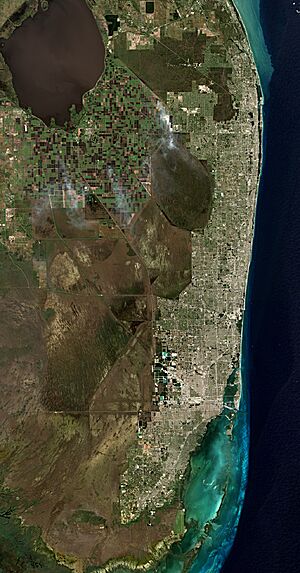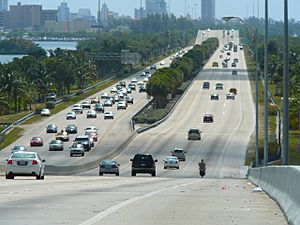Miami metropolitan area facts for kids
Quick facts for kids
Miami metropolitan area
Miami–Fort Lauderdale–West Palm Beach, FL Metropolitan Statistical Area
|
|
|---|---|
|
Metropolitan area, Megacity and combined statistical area
|
|

From top (left to right): Greater Downtown Miami, Fort Lauderdale, Sawgrass Mills, The Square at West Palm Beach, Miami Beach, and Boca Raton
|
|

Location of the Miami metropolitan area's four primary components in Florida
|
|
| Country | |
| State | |
| Core city | |
| Principal cities | |
| Area | |
| • Land | 6,137 sq mi (15,890 km2) |
| Highest elevation | Jupiter 53 ft (16.2 m) |
| Lowest elevation | Atlantic Ocean 0 ft (0 m) |
| Population
(2020)
|
|
| • Total | 6,138,333 |
| • Estimate
(2023)
|
6,183,199 |
| • Rank | 9th in the United States 1st in Florida |
| • Density | 1,000.38/sq mi (386.37/km2) |
| GDP | |
| • MSA | $483.755 billion (2022) |
| Time zone | UTC−05:00 (Eastern Standard Time) |
| • Summer (DST) | UTC−04:00 (Eastern Daylight Time) |
The Miami metropolitan area is a large coastal region in southeastern Florida. It is often called South Florida or Greater Miami. This area is the ninth-largest metropolitan area in the United States. It is also the biggest in Florida.
As of 2023, about 6.18 million people live here. This is more than the population of 31 of the 50 U.S. states! The area includes three of Florida's most populated counties: Miami-Dade, Broward, and Palm Beach.
Miami is the main city. It is a center for finance and culture. Other important cities include Fort Lauderdale, West Palm Beach, and Boca Raton. The Miami metropolitan area is part of the larger South Florida region. This region also includes the Everglades and the Florida Keys.
The urban area of Miami is very long but narrow. It stretches about 100 miles (160 km) north to south. But it is only about 5 to 20 miles (8 to 32 km) wide. This makes it the second-longest urban area in the U.S.
Many well-known colleges and universities are in this area. These include Florida Atlantic University, Florida International University, Nova Southeastern University, and the University of Miami. There are also three community colleges: Broward College, Miami Dade College, and Palm Beach State College. Some of these schools are among the largest in the United States.
Contents
What is the Miami Metro Area?
The Miami metropolitan area is officially known as the Miami–Fort Lauderdale–West Palm Beach Metropolitan Statistical Area. It is often called the "Gold Coast." This name refers to the wealth and tropical lifestyle found here.
How the Area is Defined
The U.S. government defines the Miami metropolitan area. As of 2023, it includes three main parts:
- Miami-Miami Beach-Kendall Metropolitan Division: This is Miami-Dade County.
- Fort Lauderdale-Pompano Beach-Sunrise Metropolitan Division: This is Broward County.
- West Palm Beach-Boca Raton-Delray Beach Metropolitan Division: This is Palm Beach County.
This whole area covers about 6,137 square miles (15,890 km2).
There is also a larger area called the Miami-Port Saint Lucie-Fort Lauderdale Combined Statistical Area. This wider region includes the main Miami area. It also adds the Port Saint Lucie area, Indian River County, Monroe County (where the Florida Keys are), and Okeechobee County.
Climate and Geography
Understanding the Climate
The Miami metropolitan area has a tropical climate. This is like the weather you find in many Caribbean islands. It is the only large area in the mainland U.S. with this type of climate.
The year has two main seasons:
- Wet Season: From May to October, it is hot and humid. Daily thunderstorms are common in the afternoon.
- Dry Season: From late October to late April, it is much drier. Sometimes, brush fires can be a problem during this time.
The hurricane season runs from June 1 to November 30. Hurricanes are most likely to hit between mid-August and late September. Because of its location, South Florida is one of the most likely places in the world to be hit by a hurricane. Many hurricanes have affected the area. These include Andrew in 1992 and Wilma in 2005.
Temperatures are usually warm. In summer, it rarely drops below 75°F (24°C) at night. Daytime temperatures are often in the high 80s or low 90s (30–35°C). A cool sea breeze from the Atlantic Ocean often helps to cool things down.
In winter, it is usually dry and pleasant. Average daytime highs are around 74–77°F (23–25°C). Nighttime lows are generally 55–63°F (13–17°C). Sometimes, cold fronts bring cooler weather. Temperatures might drop to the 40s (4–9°C) for a day or two. It is very rare for temperatures to fall below 40°F (4°C). Frost is almost unheard of in coastal areas.
Major Cities and Towns
Largest Cities in the Area

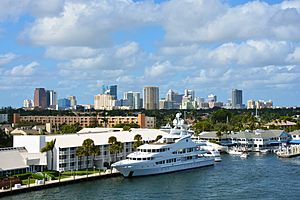

Here are the twenty largest cities in the Miami metropolitan area by population:
| City | County | 2020 population |
|---|---|---|
| Miami | Miami-Dade | 442,241 |
| Hialeah | Miami-Dade | 223,109 |
| Fort Lauderdale | Broward | 182,760 |
| Pembroke Pines | Broward | 171,178 |
| Hollywood | Broward | 153,067 |
| Miramar | Broward | 134,721 |
| Coral Springs | Broward | 133,394 |
| Miami Gardens | Miami-Dade | 111,640 |
| Pompano Beach | Broward | 112,046 |
| West Palm Beach | Palm Beach | 117,415 |
| Davie | Broward | 105,691 |
| Boca Raton | Palm Beach | 97,422 |
| Sunrise | Broward | 97,335 |
| Plantation | Broward | 91,750 |
| Miami Beach | Miami-Dade | 82,890 |
| Deerfield Beach | Broward | 86,859 |
| Boynton Beach | Palm Beach | 80,380 |
| Lauderhill | Broward | 74,482 |
| Doral | Miami-Dade | 75,874 |
| Homestead | Miami-Dade | 80,737 |
Other Communities to Know
The Miami metropolitan area has many other cities and towns. Some have populations between 10,000 and 100,000 people. These include places like Aventura, Coral Gables, Delray Beach, and Jupiter. There are also many smaller communities with fewer than 10,000 residents.
People and Culture
Population Growth and Diversity
| Miami MSA (Miami-Dade, Broward, and Palm Beach) | |||
|---|---|---|---|
| Census | Pop. | %± | |
| 1920 | 66,542 | — | |
| 1930 | 214,830 | 222.8% | |
| 1940 | 387,522 | 80.4% | |
| 1950 | 693,705 | 79.0% | |
| 1960 | 1,497,099 | 115.8% | |
| 1970 | 2,236,885 | 49.4% | |
| 1980 | 3,220,844 | 44.0% | |
| 1990 | 4,056,100 | 25.9% | |
| 2000 | 5,007,564 | 23.5% | |
| 2010 | 5,564,635 | 11.1% | |
| 2020 | 6,138,333 | 10.3% | |
| 2023 (est.) | 6,183,199 | 11.1% | |
| U.S. Decennial Census 1920–1970 1980 1990 2000 2010 2020 2023 |
|||
The Miami metropolitan area has grown a lot over the years. In 1920, only about 66,000 people lived here. By 2020, the population was over 6.1 million!
The area is very diverse. In 2020, about 45.9% of the population was Hispanic or Latino. About 29.1% were White (not Hispanic). And 18.7% were Black or African American.
Languages Spoken
Many languages are spoken in homes across the Miami area. In 2015, about 46.9% of people spoke English at home. But a large number, 41.6%, spoke Spanish. You will also hear French or Haitian Creole, especially in Broward County.
In Miami-Dade County, a special way of speaking English has developed. It is called the Miami dialect. This dialect is common among people whose families have lived in Miami for a few generations. It sounds like standard American English but has some influences from Spanish.
Religion in the Area
Religion in the Miami metropolitan area (2014) Protestantism (39%) Roman Catholicism (27%) Mormonism (0.5%) Eastern Orthodoxy (0.5%) Jehovah's Witnesses (1%) Other Christian (1%) No religion (21%) Judaism (9%) Other religion (1%)
Most people in the Miami metropolitan area are Christian. A 2014 study showed that 68% of people were Christian. This includes 39% who are Protestant and 27% who are Roman Catholic.
Judaism is the second-largest religion, with about 9% of the population. The Miami area has one of the largest Jewish communities in the United States. Other religions like Islam, Buddhism, and Hinduism are also present. About 21% of people do not identify with any religion.
Housing and Living Costs
In 2005, there were about 2.3 million homes in the Miami area. About half of these were single-family houses. The other half were in apartment buildings.
As of 2019, most people in Miami (over 70%) rent their homes. The average rent was about $1,355. This was higher than the national average.
Economy and Jobs
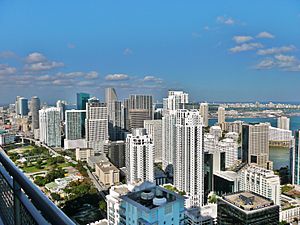
The Miami metropolitan area has a strong economy. In 2022, the total economic output (GDP) was about $483.755 billion.
Many different types of jobs are found here. About 32% of jobs are in management or professional fields. Another 30% are in sales and office work. Healthcare and social assistance are also big industries.
In 2005, most people (79%) drove to work alone. About 10% carpooled. The average time it took to get to work was about 28.5 minutes.
Education and Learning

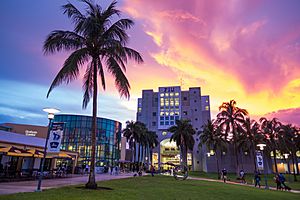
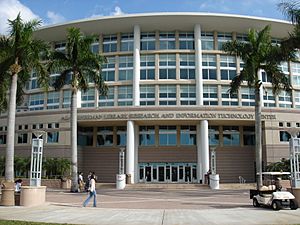
In Florida, each county has its own school district. These districts are managed by an elected school board.
The Miami-Dade County Public School District is the 4th-largest public school district in the U.S. The School District of Palm Beach County is the 11th-largest. Broward County Public School District is the 6th-largest.
The University of Miami is a highly-ranked private university. It has very selective admissions. Florida International University is one of the largest public universities in the nation. It has over 55,000 students.
Other colleges and universities in the area include:
- Barry University
- Broward College
- Florida Memorial University
- Lynn University
- Miami Dade College
- Nova Southeastern University
- Palm Beach Atlantic University
- Palm Beach State College
- St. Thomas University
In 2005, 82% of adults (25 and older) had finished high school. About 28% had a college degree or higher.
Getting Around: Transportation
Roads and Highways
The Miami area has many major roads. Five interstate highways help people travel.
- I-95 runs north and south along the coast.
- I-75 goes east and west. It connects to Naples on Florida's west coast.
- I-595 links Fort Lauderdale to I-75.
- I-195 and I-395 connect I-95 to Miami Beach.
There are also several state expressways. These include the Dolphin Expressway and the Palmetto Expressway. The Palmetto Expressway is like a ring road around urban Miami.
Airports for Travel
The area has three main commercial airports:
- Miami International Airport (MIA)
- Fort Lauderdale–Hollywood International Airport (FLL)
- Palm Beach International Airport (PBI)
These airports together form the fourth-largest travel market in the U.S. There are also several smaller airports for private planes.
Seaports for Ships

The region has four seaports. The biggest and most important is the Port of Miami. It is the busiest cruise ship port in the world. Other ports include Port Everglades and the Port of Palm Beach.
The Port of Miami is being made deeper. This will allow larger ships to enter. This project will help the port grow and create many jobs.
Public Transportation Options
Miami-Dade Transit (MDT) is Florida's largest public transport system. It has trains, people movers, and buses.
- Metrorail is Florida's only rapid transit train system. It has 23 stations.
- Metromover is a free people mover in Downtown Miami. It has 20 stations.
- Metrobus serves all of Miami-Dade County. It also goes to parts of Broward and Monroe counties.
In Broward County, Broward County Transit runs buses. In Palm Beach County, Palm Tran runs buses.
There are also commuter trains:
- Tri-Rail connects Miami, Fort Lauderdale, and West Palm Beach.
- Brightline offers faster train service. It connects Miami, Fort Lauderdale, West Palm Beach, Boca Raton, Aventura, and Orlando. There are plans to expand to Tampa and Jacksonville.
Sports and Teams
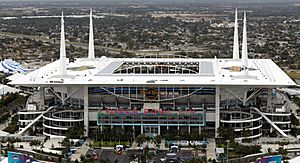
The Miami area is home to five major professional sports teams:
| Team Name | League | Sport | Home Venue | City | Championships Won |
|---|---|---|---|---|---|
| Miami Dolphins | National Football League (NFL) | Football | Hard Rock Stadium | Miami Gardens | 2 |
| Inter Miami CF | Major League Soccer (MLS) | Soccer | Chase Stadium | Fort Lauderdale | 1 |
| Miami Heat | National Basketball Association (NBA) | Basketball | Miami-Dade Arena | Downtown Miami | 3 |
| Miami Marlins | Major League Baseball (MLB) | Baseball | Marlins Park | Little Havana | 2 |
| Florida Panthers | National Hockey League (NHL) | Hockey | Amerant Bank Arena | Sunrise | 1 |
College Sports
The University of Miami has a very famous sports program, the Miami Hurricanes. Their football team has won five national championships. Their baseball team has won four national championships.
Other college teams include the Florida Atlantic Owls and the FIU Panthers.
Other Sports Events
The area also hosts other sports.
- Major League Baseball teams like the Miami Marlins and St. Louis Cardinals do their spring training here.
- The Homestead-Miami Speedway hosts NASCAR Cup Series races.
- The Palm Beach International Raceway is a smaller race track.
Images for kids
-
DRV PNK Stadium, home stadium of Inter Miami of the MLS
-
Kaseya Center, home of the Miami Heat of the NBA
-
LoanDepot Park, home of the Miami Marlins of the MLB
-
FLA Live Arena, home of the Florida Panthers
See also
 In Spanish: Área metropolitana del Sur de la Florida para niños
In Spanish: Área metropolitana del Sur de la Florida para niños


